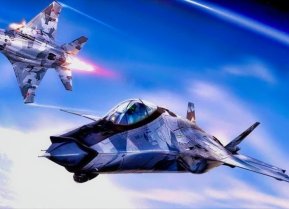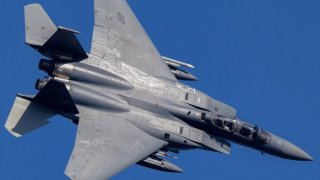5 Reasons the F-15 Strike Eagle Is Simply Amazing
The F-15E Strike Eagle was developed to conflict with the Soviet military but arrived at the end of the Cold War. It has evolved and thrived with the times.
The twin-engine, all-weather McDonnell Douglas F-15 Eagle established itself as the West's premier air superiority fighter, with a peerless victory-to-loss ratio that remains more than 100:0! Though it first entered service in 1976, it continues to remain in operation over the skies of Israel, Japan, and Saudi Arabia.
Though the F-15 was originally envisioned as a pure air-superiority aircraft, its design included a secondary ground-attack capability that was largely used.
The aircraft was further developed as the F-15E Strike Eagle, an all-weather ground-attack aircraft that still retained all of the air combat capabilities of the original Eagle. It is equipped with an array of avionics and electronics systems, which provide the F-15E the capability to fight at low altitudes, day or night, and in all weather.
Here are five key facts about the F-15 Strike Eagle:
The F-15 Strike Eagle is truly an impressive aircraft - and here are all of the reasons why.
It is Really a 1980s Aircraft Produced at the End of the Cold War
The development of the F-15E Strike Eagle began in the 1980s as an upgrade to the "second generation" F-15C air superiority fighter, while the variant made its first flight in December 1986.
As a dual-role fighter designed to perform air-to-air and air-to-ground missions, the first production model of the F-15E was delivered to the 405th Tactical Training Wing, Luke AFB, Arizona, in April 1988.
The Strike Eagle Has a Crew of Two
In the front cockpit, the F-15E features redesigned controls for the pilot, along with a wide-field-of-view head-up display and three CRT displays that provide the pilot with navigation, weapon delivery, and systems operation data.
The rear seat of the aircraft is occupied by the weapons system officer (WSO), who is provided with four multipurpose terminals for radar, weapons selection, and monitoring of enemy tracking systems. The screens further employ an electronic "moving map" to navigate, while two hand controls are used to select new displays and to refine targeting information. Displays can be moved from one screen to another, chosen from a menu of display options.

This provides for effective mission coordination and workload sharing.
Better Than Eagle Eyes
The F-15 Strike Eagle's navigation system employs a laser gyro and a Global Positioning System to continuously monitor the aircraft's position and provide information to the central computer and other systems, including the digital moving map in both cockpits.
The aircraft's APG-70 radar system allows aircrews to detect ground targets from long ranges. A key feature of the system is that after a sweep of a target area, the crew freezes the air-to-ground map and then goes back into air-to-air mode to clear for air threats. During the air-to-surface weapon delivery, the pilot is capable of detecting, targeting, and engaging air-to-air targets while the WSO designates the ground target.
According to the United States Air Force, the low-altitude navigation and targeting infrared for night, or LANTIRN, system allows the aircraft to fly at low altitudes, at night and in any weather conditions, to attack ground targets with a variety of precision-guided and unguided weapons. The LANTIRN system, consisting of two pods attached to the exterior of the aircraft, gives the F-15E unequaled accuracy in weapons delivery day or night and even in poor weather.

The navigation pod contains terrain-following radar which allows the pilot to safely fly at a very low altitude following cues displayed on a heads-up display. This system also can be coupled to the aircraft's autopilot to provide "hands-off" terrain-following capability.
It Can Soar Like an Eagle and Then Some
The wings of the F-15 Strike Eagle are based around an extremely strong torque box of light alloy and titanium, to which are attached wingtip sections, flaps, and ailerons of aluminum honeycomb. Its wingspan is 42 feet 9.6 inches (13.045 meters).
The F-15E is powered by two Pratt & Whitney F100-PW-220 or 229 engines that incorporate advanced digital technology for improved performance.
The Strike Eagle has a max takeoff weight of 81,000lb, while its maximum speed is 1,650 mph/Mach 2.5 at high altitude, and it can cruise at 900 mph/Mach 1.2 at low altitude. It has a combat range of 791 miles (1,272 km).
The F-15E is a Warbird With Serious Claws
The Strike Eagle has four wing pylons, fuselage pylons, and bomb racks on CFTs with a capacity of 23,000 lb (10,400 kg) of external fuel and ordnance. It can carry a mix of ordnance including four AIM-7 Sparrow, four AIM-9 Sidewinder, four AIM-120 AMRAAM air-to-air missiles; as well as up to six AGM-65 Maverick, two AGM-84 Harpoon, two AGM-84H/K SLAM-ER, AGM-130, AGM-154 JSOW, AGM-158 JASSM ground attack missiles.

It is further able to carry a variety of bombs, including the GBU-28 "Bunker Buster" and B61 or B83 nuclear bomb.
In addition, the F-15 Strike Eagle is armed with a 20 mm (0.787 in) M61A1 Vulcan 6-barreled Gatling cannon, with 500 rounds of either M-56 or PGU-28 ammunition.
The F-15E Strike Eagle was developed to conflict with the Soviet military but arrived at the end of the Cold War.
Despite that fact, it has seen action in numerous conflicts, including the 1991 Gulf War, Operation Enduring Freedom, and Operation Iraqi Freedom. It has proven to be a highly capable and versatile platform, demonstrating its effectiveness in both air-to-air and air-to-ground missions.
Author Experience and Expertise
Peter Suciu is a Michigan-based writer. He has contributed to more than four dozen magazines, newspapers, and websites with over 3,200 published pieces over a twenty-year career in journalism. He regularly writes about military hardware, firearms history, cybersecurity, politics, and international affairs. Peter is also a Contributing Writer for Forbes and Clearance Jobs. You can follow him on Twitter: @PeterSuciu.
All images are from Shutterstock.


